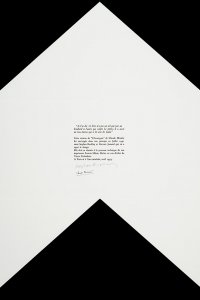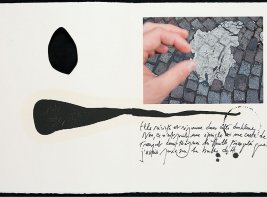Chroniques
Year: 1993
Author: Claude Minière (*1938)
Artist: Stephen Buckley (*1944)
Publisher: Collectif Génération
A poem as a dance
The text begins - like James Joyce's Finnegans Wake - with the word 'riverrun': 'riverrun: duo, dance; against the labyrinth; she; two words for nature; homage to Montaigne'. The dance is the poet's true rival, according to Minière, for there is always a point in poetry at which we lose ourselves in declensions, which in linking verbs make the world go round, conversations are conserved and dancing enters the picture through metre, thereby 'kidnapping' the poem. It's a dance in the same way that atoms and electrons dance around each other, in hatred and in love, in everything we see: 'in the sun, at night, in the chill of a first thought.' According to Minière, we too are like photons: particles of light. At the poem's end, Minière greets the philosophers Empedocles and Montaigne: 'Et, là, il arrive il arriva à sortir une ligne du fouillis', ending with a thread that appears out of the confusion. Minière has orchestrated the languages in his poems as intentional chaos, leaping from one sound to another, from one rhythm to another, from one association to another. Minière wants the poem and thoughts about that poem (those of the reader as well as those of the author) to conjoin and form a single text.
Three editions of this text were published: one with illustrations by Toni Grand (in 1991), one with gouaches by Eléna Berriolo (1993), and one with gouaches by Stephen Buckley (1993), of which this is a copy. Publisher Gervais Jassaud discussed the idea for the book with the artist in July 1991. The book was printed in 1993 by Francis Mérat in his studio in Paris, in an edition of 12 copies, which, having original gouaches, are similar to each other, but not completely identical. Both 1993 editions have been designed to offer the reader a choice on each page: do I read the text or look at the gouache? The reader will initially do both. The paper has however been folded or cut, creating triangular shapes that reveal only half of the image or text. Many of the pages are like that: pages in which only the text is legible, but in which the illustration will appear by lifting up a slip of paper - or vice versa. There are also pages in which half the text is visible along with half the gouache: lifting the triangle here actually completes the text or the image. This sounds complicated, but it is actually a simple invention, created by a simple act. It was done with the intention of making the reading process unpredictable and multifarious, by 'mobilizing' the reading process.
D.I.Y. enthusiast
Stephen Buckley's paintings play a somewhat similar game with the viewer. He alternates between hiding or revealing his sources of inspiration, especially through the titles of the works. The artist, who was born in Leicester in 1944, was influenced by Pop Art and his meetings with Francis Picabia, Kurt Schwitters and Marcel Duchamp around 1960. The construction of hisis often showy, yet the various materials he uses bear the mark of a D.I.Y. enthusiast: shoe polish, liquid rubber, Plexiglas, pieces of carpet and old clothes. The materials are ripped, folded and stapled together, screwed and woven. His paintings mainly include everyday objects, like architectural motifs, but also ducts and sewing patterns.
This book was printed in a limited edition of only 12 copies, but this isn't mentioned in the colophon, because the publisher had often experienced artists destroying some of the copies out of dissatisfaction, or taking so much time to complete them that they never managed to finish the entire edition. As a precaution, the total number of copies was therefore not listed in the colophon. Throughout this process, the publisher was very much aware of his illustrious predecessors: Vollard, Kahnweiler, Tériade, and Iliazd. Like them, Jassaud wishes to leave behind a testimony of his own age in the books he publishes.
Bibliographical description
Description: Chroniques / Claude Minière [texte] ; Stephen Buckley [peintures originales en couleurs]. - Colombes : Collectif Génération, [1993]. – [6] quires : ill. ; 23×26 cm
Printer: Francis Mérat (Paris)
Edition: 12 copies
Note: Signed by the author and the artist
Bibliography: Bénézit 2-928
Shelfmark: KW Koopm L 500
References
- Debra Bricker Balken, 'Notes on the publisher as Auteur', in: Art journal, 52 (1993) 4 (Winter), p. 70-71
- Paul van Capelleveen, Sophie Ham, Jordy Joubij, Voices and visions. The Koopman Collection and the Art of the French Book. The Hague, Koninklijke Bibliotheek, National Library of the Netherlands; Zwolle, Waanders, 2009
- Paul van Capelleveen, Sophie Ham, Jordy Joubij, Voix et visions. La Collection Koopman et l'Art du Livre français. La Haye, Koninklijke Bibliotheek, Bibliothèque nationale des Pays-Bas; Zwolle, Waanders, 2009
- Le corps du livre: L'oeuvre éditoriale de Gervais Jassaud. Nîmes, Carré d'art bibliothèque, Ville de Nîmes, 1998
- Marco Livingstone, Stephen Buckley, many angles. Oxford, Museum of Modern Art, 1985
- Jean-Charles Masséra, 'Le livre à la recherche de son langage: L'exemple de Collectif Génération', in: Bulletin du bibliophile, (1991), p. 105-140


!['Chroniques', pagina [4]](/sites/default/files/styles/galerie/public/images/chroniques-p4.jpg?h=3c1c858c&itok=LXBu9Ohb)
!['Chroniques', pagina [18-19]: tekst met gouache in oranje engoud (beidehalf afgedekt)](/sites/default/files/styles/galerie/public/images/chroniques-p18-19.jpg?h=149a0d71&itok=Q73uAfDb)
![Pagina's [6] en [7], links- en rechtsboven uitgevouwen](/sites/default/files/styles/galerie/public/images/chroniques-p6-7-uitgevouwen.jpg?h=92b5c4fc&itok=9Lc8cE9a)
![Pagina's [6] en [7]: links- onder uitgevouwen](/sites/default/files/styles/galerie/public/images/chroniques-p6-7-uitgevouwen-4.jpg?h=f574e291&itok=o0QaDH36)
![Pagina's [6] en[7]: linksonder en rechtsboven uitgevouwen](/sites/default/files/styles/galerie/public/images/chroniques-p6-7-uitgevouwen-2.jpg?h=f5958062&itok=Sp9FNOhr)
![Pagina's [6] en [7]: links- en rechtsonder uitgevouwen](/sites/default/files/styles/galerie/public/images/chroniques-p6-7-uitgevouwen-3.jpg?h=f574e291&itok=Ic6scecG)
![Pagina's [6] en [7]: linksboven en rechtsonder uitgevouwen](/sites/default/files/styles/galerie/public/images/chroniques-p6-7.jpg?h=201e2d68&itok=C3rp3lkB)

![Originele penseelstreek door U-Fan Lee (p. [7])](/sites/default/files/styles/gerelateerd_item_mob/public/images/un-poleoscope-p7.jpg?h=198f24f7&itok=zjLgnYt8)
![Illustraties door Claude Viallat (p.[4]-[5])](/sites/default/files/styles/gerelateerd_item_mob/public/images/as-you-like-it-do-it-yourself-p4-5.jpg?h=23a3a14b&itok=B_Z0eeHO)
